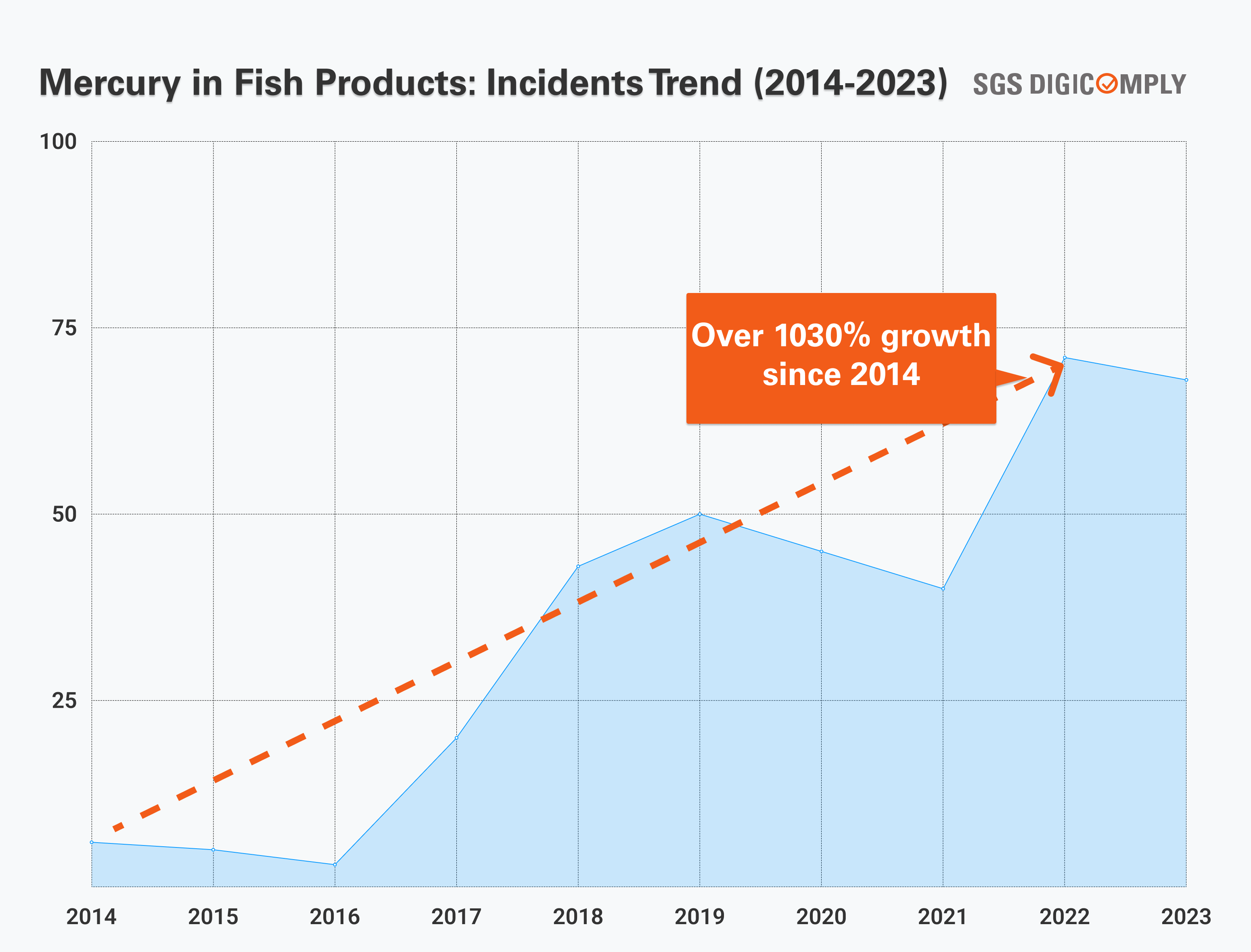Mercury is a naturally occurring element that can be found in various forms in the environment. While it exists in trace amounts in the Earth's crust, human activities, particularly industrial processes, have contributed to an increase in mercury levels in certain ecosystems. One of the primary pathways through which humans are exposed to mercury is the consumption of fish, as mercury tends to bioaccumulate in aquatic organisms. This article aims to explore the risk assessment associated with mercury in fish products and discuss effective control measures to mitigate potential health risks.
Risk Assessment
Sources of Mercury in Fish:
1. Natural Sources:
- Volcanic Activity: Volcanic eruptions release mercury into the atmosphere, which eventually settles into water bodies.
- Weathering of Rocks: Erosion of rocks contributes to the release of mercury into soil and water.
- Forest Fires: The combustion of vegetation during forest fires can release mercury into the air and subsequently into water systems.
2. Anthropogenic Sources:
- Industrial Processes: Various industries release mercury as a byproduct of manufacturing processes, contributing to environmental contamination.
- Coal Combustion: Burning coal for energy generation releases mercury, which can find its way into water bodies through air deposition or runoff.
- Waste Incineration: The incineration of waste materials, including electronic waste, can release mercury into the environment.
Bioaccumulation in Fish:
1. Mercury Transformation:
- Mercury, in its inorganic form, undergoes biological and chemical transformations in aquatic environments.
- Methylmercury Formation: Microorganisms convert inorganic mercury into methylmercury, a more toxic and readily bioavailable form.
2. Predatory Fish and Food Chain Dynamics:
- Larger Predatory Fish: Predatory species like shark, swordfish, and tuna, occupy higher trophic levels in the food chain.
- Bioaccumulation: As smaller fish and organisms absorb methylmercury, it concentrates in their tissues. Larger predators that consume these smaller organisms accumulate higher levels of mercury.
Health Risks for Consumers:
1. Methylmercury Exposure:
- Neurological and Developmental Issues: Methylmercury is particularly harmful to the nervous system, leading to neurological impairments and developmental issues.
- Fetal and Childhood Effects: Pregnant women and young children are more susceptible to the adverse effects of methylmercury exposure.
2. Long-term Health Impacts:
- Cardiovascular Problems: Prolonged exposure to elevated mercury levels has been associated with cardiovascular issues.
- Impaired Immune Function: Mercury toxicity may compromise the immune system, making individuals more susceptible to infections.
- Other Health Issues: Chronic exposure can contribute to a range of health problems, including kidney damage and reproductive issues.
In summary, understanding the diverse sources of mercury contamination, the process of bioaccumulation in aquatic ecosystems, and the associated health risks for consumers is crucial for developing effective risk assessment and control measures in the context of fish products. This knowledge forms the basis for implementing targeted interventions to minimize mercury exposure and protect both human health and the environment.
Control Measures
Regulatory Standards:
1. Establish and Enforce Standards:
- Setting Limits: Governments and regulatory bodies need to set specific limits for mercury levels in fish products, considering the health risks associated with methylmercury.
- Legal Framework: Develop and enforce legal frameworks that mandate compliance with these standards across the fish industry.
2. Regular Updates and Monitoring:
- Dynamic Standards: Regulatory standards should be dynamic, subject to periodic updates based on the latest scientific research and risk assessments.
- Continuous Monitoring: Implement continuous monitoring systems to track mercury levels in fish and assess the effectiveness of existing standards.
Monitoring and Surveillance:
1. Routine Monitoring Programs:
- Periodic Sampling: Conduct routine sampling of fish populations from various locations to monitor mercury concentrations.
- Data Collection: Gather data on mercury levels to identify trends, potential hotspots, and emerging issues.
2. Surveillance of Fishing Areas:
- Fishing Grounds: Monitor and regulate activities in fishing grounds to ensure sustainable practices and prevent overfishing.
- Aquaculture and Processing Plants: Conduct regular inspections of aquaculture facilities and processing plants to verify adherence to mercury standards.
Consumer Awareness and Education:
1. Educational Campaigns:
- Risk Communication: Launch educational campaigns to inform consumers about the risks associated with mercury in fish consumption.
- Targeted Information: Provide specific information about high-mercury species and suggest alternatives with lower mercury content.
2. Labeling and Certification:
- Clear Labeling: Implement clear and informative labeling on fish products indicating mercury levels.
- Certification Programs: Support certification programs that ensure adherence to safety standards and provide consumers with confidence in their choices.
Technological Interventions:
1. Emission Reduction Technologies:
- Industrial Processes: Invest in and promote technologies that reduce mercury emissions from industrial activities, such as coal-fired power plants and metal smelting facilities.
- Waste Management: Implement advanced waste management technologies to minimize mercury releases during waste incineration.
2. Sustainable Fishing Practices:
- Selective Fishing Gear: Promote the use of selective fishing gear to target specific species, reducing bycatch and the inadvertent capture of high-mercury fish.
- Aquaculture Best Practices: Develop and advocate for sustainable aquaculture practices that minimize environmental contamination and mercury accumulation.
International Collaboration:
1. Global Initiatives:
- Information Exchange: Facilitate the exchange of information among countries regarding mercury pollution, research findings, and best practices.
- Joint Research Projects: Collaborate on international research projects to enhance understanding and develop effective global strategies.
2. Harmonization of Standards:
- Common Standards: Work towards harmonizing international standards for mercury levels in fish products to ensure consistency and effectiveness.
- Joint Enforcement: Collaborate on enforcement mechanisms to prevent the import and sale of fish products that do not meet established standards.
In summary, a comprehensive approach to controlling mercury in fish products involves a combination of regulatory measures, monitoring and surveillance, consumer education, technological interventions, and international collaboration. These strategies collectively contribute to reducing mercury exposure, protecting public health, and ensuring the sustainability of fisheries worldwide.
SGS Digicomply Food Safety Intelligence Hub
The data obtained from the SGS Digicomply Food Safety Intelligence Hub reveals a significant and alarming trend in incidents related to mercury in fish products over the period from 2014 to 2023. The observed growth in incidents during this timeframe is staggering, surpassing 1030%.

This sharp increase raises concerns about the safety of fish products in the market and underscores the pressing need for comprehensive measures to address and mitigate the risks associated with mercury contamination. The implications of such a substantial rise in incidents emphasize the importance of implementing stringent regulatory standards, continuous monitoring, and international collaboration to safeguard consumer health and ensure the sustainability of fish products industry.
Feel free to get in touch now to learn about implementing the Food Safety Intelligence Hub for your company.
Conclusion
Risk assessment and control measures for mercury in fish products are crucial for safeguarding public health and maintaining the sustainability of aquatic ecosystems. By implementing robust regulatory frameworks, monitoring programs, and technological interventions, stakeholders can work together to mitigate the risks associated with mercury exposure while ensuring the availability of safe and nutritious fish products for consumers.





.webp?width=1644&height=1254&name=Food%20Safety%20Dashboard%201%20(1).webp)
